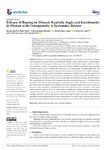Mostrar o rexistro simple do ítem
Efficacy of Bracing on Thoracic Kyphotic Angle and Functionality in Women with Osteoporosis: A Systematic Review
| dc.contributor.author | Sánchez-Pinto-Pinto, Beatriz | |
| dc.contributor.author | Romero-Morales, Carlos | |
| dc.contributor.author | López-López, Daniel | |
| dc.contributor.author | Labra, Carmen de | |
| dc.contributor.author | García-Pérez-de-Sevilla, Guillermo | |
| dc.date.accessioned | 2022-09-06T11:44:55Z | |
| dc.date.available | 2022-09-06T11:44:55Z | |
| dc.date.issued | 2022-05-24 | |
| dc.identifier.citation | Sánchez-Pinto-Pinto, B.; Romero-Morales, C.; López-López, D.; de-Labra, C.; García-Pérez-de-Sevilla, G. Efficacy of Bracing on Thoracic Kyphotic Angle and Functionality in Women with Osteoporosis: A Systematic Review. Medicina 2022, 58, 693. https://doi.org/10.3390/medicina58060693 | es_ES |
| dc.identifier.issn | 1648-9144 | |
| dc.identifier.uri | http://hdl.handle.net/2183/31520 | |
| dc.description.abstract | [Abstract] Background and purpose: Osteoporotic hyperkyphosis is associated with adverse outcomes, such as fatigue, back pain, or reduced back extensor strength, with a negative impact on functionality and quality of life. The purpose of this review is to assess the effectiveness of spinal orthosis on these adverse effects. Methods: A systematic review following the PRISMA guidelines was performed. Inclusion criteria were (1) women with osteoporosis; (2) randomized controlled trials only; and (3) type of intervention: spinal bracing. Exclusion criteria were (1) article not written in English; (2) full-text not available; and (3) no kyphosis assessment. Quality-of-life variables such as back pain, functional variables such as back extensor strength, and osteoporotic-related variables such as lumbar spine bone mineral density were extracted and recorded before and after the intervention. The characteristics of the intervention programs were also extracted and recorded. The characteristics of studies, interventions, and participants are summarized in a table. Then, the revised Cochrane risk-of-bias tool for randomized trials (RoB 2) was used to assess the quality of the studies. Results and Discussion: Four randomized controlled trials with a low risk of bias were included (n = 326 women with osteoporosis, aged 51–93 years). Interventions consisting of wearing a dynamic hyperextension orthosis for at least two hours per day for six months improved functionality, mobility, back extensor strength, respiratory function, and reduced the thoracic kyphosis angle. Conclusions: Spinal orthosis, especially dynamic hyperextension braces, seems effective in improving the adverse outcomes of osteoporotic hyperkyphosis. It does not seem necessary to wear the orthosis during all daily activities. | es_ES |
| dc.language.iso | eng | es_ES |
| dc.publisher | MDPI | es_ES |
| dc.relation.uri | https://doi.org/10.3390/medicina58060693 | es_ES |
| dc.rights | Atribución 4.0 Internacional | es_ES |
| dc.rights.uri | http://creativecommons.org/licenses/by/4.0/ | * |
| dc.subject | Osteoporosis | es_ES |
| dc.subject | Bracing | es_ES |
| dc.subject | Spinal orthosis | es_ES |
| dc.subject | Kyphosis | es_ES |
| dc.title | Efficacy of Bracing on Thoracic Kyphotic Angle and Functionality in Women with Osteoporosis: A Systematic Review | es_ES |
| dc.type | info:eu-repo/semantics/article | es_ES |
| dc.rights.access | info:eu-repo/semantics/openAccess | es_ES |
| UDC.journalTitle | Medicina | es_ES |
| UDC.volume | 58 | es_ES |
| UDC.startPage | 693 | es_ES |
| dc.identifier.doi | 10.3390/medicina58060693 |
Ficheiros no ítem
Este ítem aparece na(s) seguinte(s) colección(s)
-
INIBIC-NEURO - Artigos [48]
-
GI-NEURO - Artigos [158]






